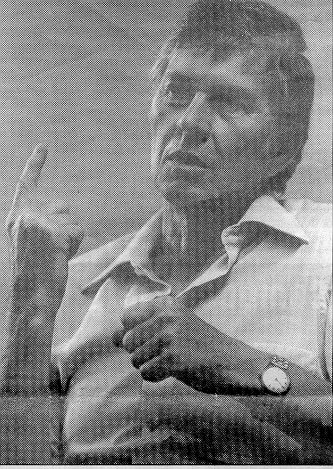
William C. Stokoe Jr.'s biography
(July 21, 1919 - April 4, 2000)
|
Father of ASL |
Dr. William C. Stokoe (pronounced STOH-key) Jr., a renowned linguistics pioneer and a Gallaudet University professor emeritus of linguistics who was known in the Deaf community as "Father of ASL" for his significant contributions to ASL (American Sign Language). Stokoe's research on ASL linguistics, personal advocacy and published works led to the recognition that the American Sign Language is a true, fully formed, human language with its own syntax, semantics and grammatical structures, thus overcoming the contentions of linguists that it was little more than a rudimentary imitation of the spoken word. |
Prior to his service in Gallaudet, he had no knowledge of Sign language.
In the 1950's, many people perceived American Sign Language as "broken English" and did not regard it as a true language.
The use of ASL was prohibited from many educational institutions.
It was Stokoe's friendship with Dean George Detmold that led to his career in Gallaudet.
In the fall of 1955, the dean at Gallaudet College hired Stokoe as the chair
of the Department of English. In the following year, William C. Stokoe arrived at Gallaudet College (later Gallaudet University) to teach English where he was first exposed to deaf people signing.
Because of his expertise in Old and Middle
English, Dr. Stokoe was offered the job in teaching but reluctantly took it since he did
not know how to sign. While he taught students and learned signs, he realized
that his signs were not like the deaf faculty members and deaf students used.
He recognized that they communicated with each other smoothly.
While most of his colleagues and a vast majority of linguists dismissed signing as mere mimicry of speech,
Stokoe saw in it elements of a distinctive language all its own. Then he pursued
researching on language itself. However he received harsh criticism and
skepticism from his colleagues. Other faculty members ridiculed or reviled
him, and many deaf members of the Gallaudet community laughed at his efforts.
Still he maintained his belief that there is more to the sign language than meets the eye.
Dr. Stokoe's breakthrough came in 1960, five years after his arrival in Gallaudet when his book Sign Language Structure: An Outline of the Visual Communication Systems of the American Deaf. was published. At first, he did not receive much support but thereafter his continuing research on the linguistics of ASL silenced the critics. In 1965, Stokoe, along with Carl Croneberg and Dorothy Casterline co-wrote A Dictionary of American Sign Language on Linguistic Principles.Those books helped prove that sign language paased the definition of a language. Stokoe's beliefs gradually drew wide acceptance and persuaded schools for the deaf to re-evaluate their approaches.
Thanks to Dr. Stokoe's hard labors, American Sign Language scientifically and unequivocally met the full criteria of linguistics--phonology, morphology, syntax, semantics and use of language--to be classified as a fully developed, natural, independent, mature and real language.
In 1971, William Stokoe gave up his post as English Department Chairman and devoted all of his time to linguistics. And the following year, he became the director of the Linguistics Research Laboratory which he established at Gallaudet until 1984. Later in 1972, he edited the journal Sign Language Studies to sustain an unpopular dialogue until it ended in 1996. Afterwards, he was awarded for his remarkable achievements in the field of ASL linguistics. In May 1988, he received an Honorary Degree for his advocacy of ASL linguistics from Gallaudet University.
Following Dr. Stokoe's retirement from Gallaudet in 1984, he was named Professor Emeritus and was awarded an honorary doctorate by the University in 1988. He also received honorary doctorates from the University of Copenhagen in Denmark and Madonna University in Michigan. Dr. Stokoe was a fellow of the American Academy of Arts and Sciences and a member of the Cosmos Club of Washington D.C. He was a past president of the St. Andrews Society of Washington and had served as pipe major of the Washington Scottish Pipe Band. His hobbies included playing the bagpipes.
In addition to his work on ASL, Dr. Stokoe was also one of a group of international scholars who led a revival of scientific interest in the origin and evolution of the human capacity for language Throughout his life, William Stokoe wrote, co-wrote and contributed many books relating to the Study of Sign Language. His also owned and operated his own publishing company, Linstok Press, with his wife, Ruth Stokoe until 1997. He traveled widely around the world, speaking and delivering papers on the subject of Sign Language.
William Stokoe died of Myeloma which was known as bone cancer on April 4, 2000 in his home in Chevy Chase, MD.

|
Definition of ASL A short name for American Sign Language
It is a genuine language.
It is the signed language of the Deaf World in the U.S. It is visual-gestural and visual-manual.
It has it's own grammar and syntax. It is not based on English but has a structure that more closely resembles French. It is the fourth most used language in America.
|
|
|
|
|
|
|
|
|
|
|